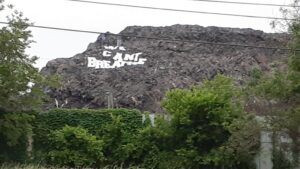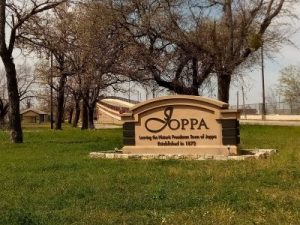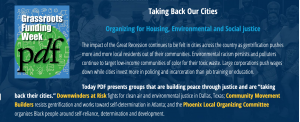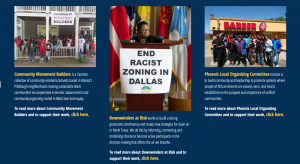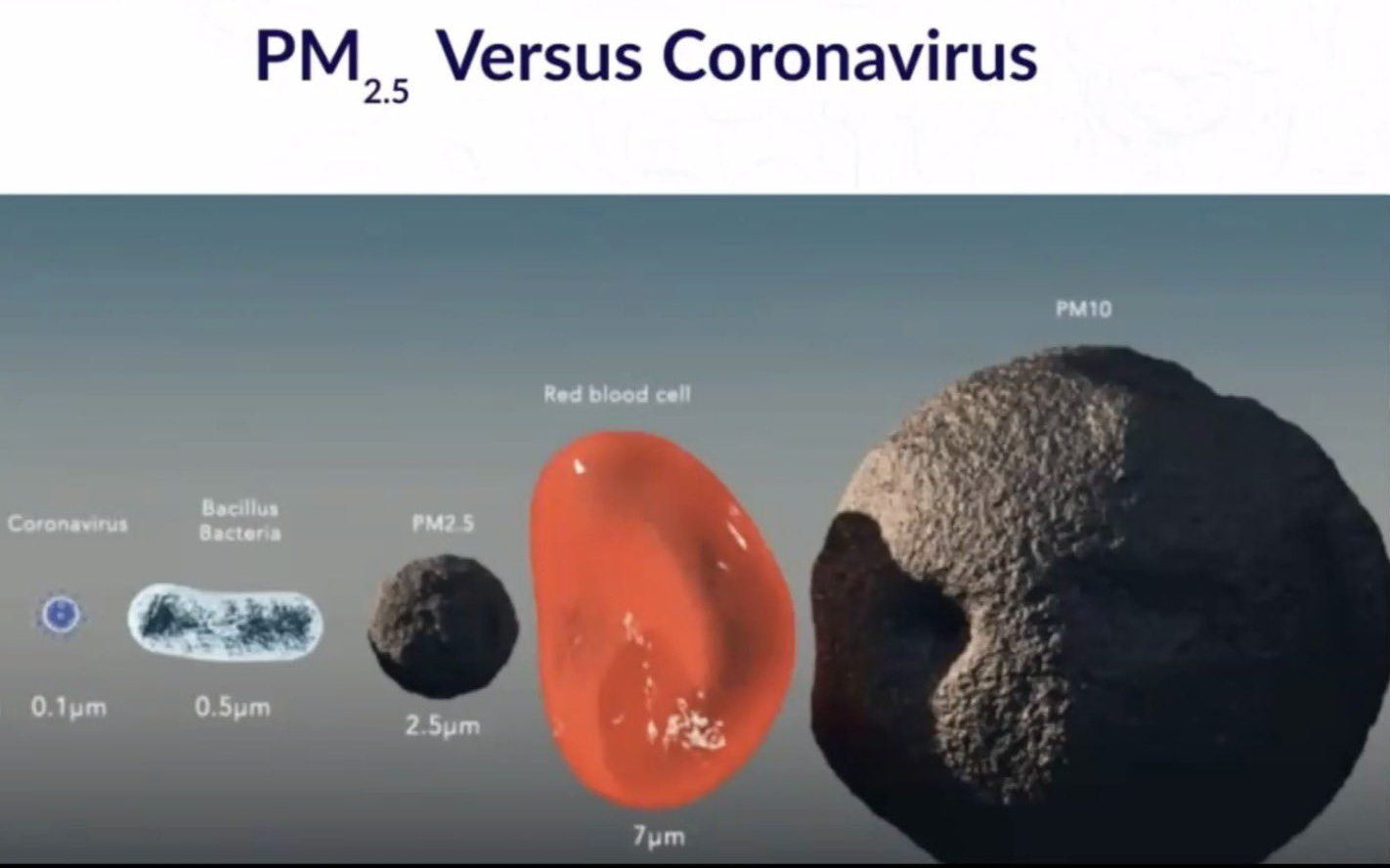Particulate Matter
Stay Inside. Plant Trees. An Annotated Guide to City of Dallas Air Quality Monitoring
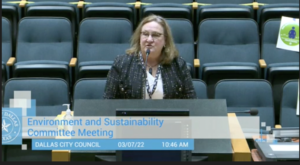
Over the last couple of weeks, the staff responsible for the Air Quality Department at Dallas City Hall’s Office of Environmental Quality have been making the rounds giving presentations about their official air quality monitoring efforts. You can find their complete PowerPoints here as PDFs on the agenda: https://cityofdallas.legistar.com/MeetingDetail.aspx?ID=903849&GUID=B69AEEB6-D5DA-4AE2-B8A4-5BB13C3FD4BE&Options=info|&Search=
The presentations are divided into two parts. The first deals with the monitors placed in Dallas as part of the State and federal enforcement to monitor DFW’s status as a “non-attainment area” for ozone, or smog. The second is about the “non-regulatory” (i.e not EPA-certified) air monitoring staff has been doing that has up to now has been going on under the “Breathe Easy” banner with a fleet of 12 monitors due to expire this year.
New federal grants have made it possible for the City to buy 35 new “non-regulatory” air monitors of various sizes and capabilities that are aimed at “community monitoring.” By the terms of the grants, five of these have to be placed in two West Dallas zip codes. The other 30 include six larger, more sophisticated air monitors that also come with their own metrological towers and will be placed at the City’s discretion.
This is quite an upgrade for a Department that only a short time ago was dismissing the idea of community monitoring and is in their fourth year of rejecting Joppa residents’ pleas for an air monitor in their neighborhood. That’s the good news.
What’s unclear is how all this new monitoring capability will be used to move the needle of air pollution exposure in Dallas.
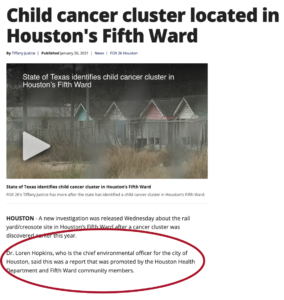
Houston has a staff toxicologist that identifies AND advocates for environmental health. Why doesn’t Dallas?
Is the City collecting air quality data so residents can brace themselves on “bad air days”, or are they collecting it to shape City Hall policy that could reduce air pollution and its impacts?
When the goals of all this City air monitoring come up in the new presentations, there’s no mention mention of impacting Dallas City Hall policy. Instead, there are boasts about gathering ““high quality data,” “contributing to local and regional databases,” and “better understanding the performance of low cost sensors” for “public health measures” and “understanding the role air pollution may play in pediatric asthma” (Really? there’s lots of studies already proving this link)
No suggestion for any pro-active City policy to reduce air pollution. No talking point about using the data to address environmental racism or increase City Hall’s much-valued “Equity” in air quality. There’s a lot of emphasis on collecting data but not much attention paid at all to what will be done with that data.
During the Question and Answer session that followed the presentations in front of the Dallas City Council’s Environmental Committee, staff suggested the results of the monitoring could be used to further the City’s air quality goals like…..staying indoors when pollution is bad, and planting trees to mitigate it. Honest.
Dallas City Council Member Jaynie Schultz:
“What are we going to do to reduce air pollution as a result of this data, this incredible trove of information we’re gathering? ….Will you be proposing to Council different things we can do to reduce that asthma so we can actually affect those numbers?
Office of Environmental Quality and Sustainability Assistant Director Susan Alvarez:
“We are currently working with our Office of Data Analytics to get that data added to the big data website so it will be publicly available. This is one piece of our grant for the West Dallas project; is to also develop appropriate messaging and to work with a non-profit on that to get that message into some of those schools where we have higher than average pediatric asthma rates….
CM Schutlz: But what’s the message? I’m sorry to interrupt.
Alvarez: The message is related to how to, um, best avoid, um, outside, outdoor activities. The other thing that we’re doing is working with the Texas Trees Foundation on, ah, piloting some interventions using nature based solutions, AKA, trees, and they’re working on that right now. They’re already working on planting vegetative screens”
It’s these kind of circa-1990’s answers that reveal why modern public health expertise is so needed at OEQS and City Hall. And not just included in the mix, buy actually driving City Hall environmental thinking. Data collection without application to policy is the Status Quo.
No OEQS staff holds a public health degree, has done research on the public health effects of air pollution, or is charged with evaluating air pollution levels from a public health perspective. When very high levels of air pollution are picked up by any of these new monitors, OEQS won’t have anyone on staff who’ll have the expertise to tell residents what that means.
Instead, the City will still be making residents do all the heavy lifting of solving problems the City helped create. You’re not only assigning them the task of linking pollution levels to impacts but also making it their responsibility to come up with the answer to cutting that linkage. This is what happened at Shingle Mountain. This is what’s happening in Joppa. This is what’s happening in West Dallas. Despite a fleet of new monitors, the City’s stance seems to be that we’re just collecting the numbers. What people do with them isn’t up to us.
Imagine that being the City’s response to finding levels of toxins in tap water faucets in Dallas neighborhoods. City Hall wouldn’t just publish the information in hopes of residents avoiding drinking the water. City Hall would take action to provide fresh water and eliminate the harm. But for some reason the City feels under no obligation to address toxic air quality in homes the same way.
There are a total of 20 slides in the two presentations. Here’s a brief annotated guide to the four slides that provide the crux of the City’s information:
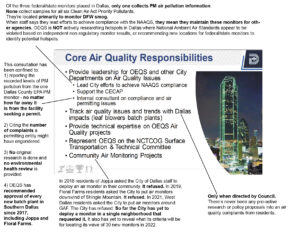
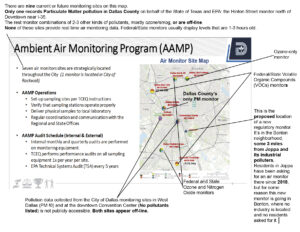
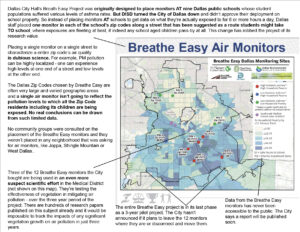
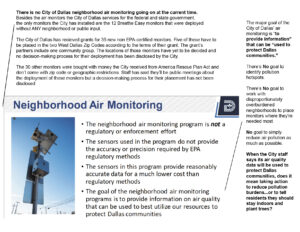
The City of Dallas’ approach to air pollution in its city limits is reminiscent of the old Community Organizing story about the village that finds abandoned babies floating downstream along its river banks and decides to organize to do something about it. At first there’s only a few, but after a couple of weeks there’s hundreds. Adoption bureaucracies are established. Seal Teams of Baby rescuers are on call 24/7. Special baby dams are built.
Until one day some smartass villager asks: “Why don’t we go upstream to see why the babies are ending up in the river?”
Dallas is always responding after the fact to air pollution problems in a downstream way when residents want them to go upstream and solve the real problems. Problems its often responsible for creating in the first place.
Instrumentation without context and action is pointless. “Neighborhood monitoring” without neighborhood oversight is worthless.
If the City of Dallas wants to maximize the potential of so many new air monitors, it needs real public health expertise to tell residents not just to avoid the danger, but how the danger can be eliminated. And neighborhoods must be driving its monitoring deployment process, not just informed after the fact or consulted on a token basis.
But right now there’s absolutely no process in place at Dallas City Hall to ensure either.
One of Dallas’ Biggest Polluters Appears to Be Breaking the Law in West Dallas
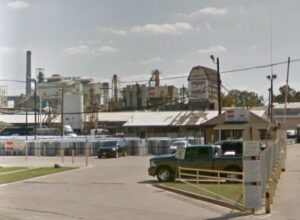 FOR IMMEDIATE RELEASE : 8 am Wednesday July 21
FOR IMMEDIATE RELEASE : 8 am Wednesday July 21
Contact: Raul Reyes Jr.: President, West Dallas 1 – 469-880-3811
Evelyn Mayo, Neighborhood Self-Defense Project – 774-810-0849
“GAF is the new RSR.”
Alliance Says West Dallas Polluter is Operating Illegally and Poisoning Residents…Just Like Infamous Lead Smelter. And They Want it Gone.
Giant shingle factory doesn’t have needed permits from City; Monitors show its likely violating federal air pollution standards too
(Dallas)– In a stunning replay of West Dallas environmental justice history, a new alliance of
groups says the largest polluter in West Dallas lacks required City of Dallas documents to operate, and could be in potential violation of federal air pollution standards. It’s the same circumstances that forced the former RSR lead smelter, once also located on Singleton Boulevard, to close in the 1980’s.
“GAF is the new RSR” said Raul Reyes, President of neighborhood group West Dallas 1, and spokesperson for the new coalition of allies, “This factory is operating illegally, lacks basic pollution controls, and is too dirty to be doing business in West Dallas neighborhoods. And just like RSR, it should be closed.”
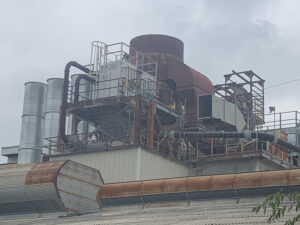 GAF has operated its West Dallas asphalt shingle factory for so long a lot of its pollution is “grandfathered” – unfiltered by any modern controls like “scrubbers” despite that technology being capable of removing up to 99% of sulphur dioxide emissions. In the last EPA inventory available from 2019, it was listed as Dallas County’s third largest air polluter with over 260 tons being spewed from GAF into surrounding neighborhoods that year alone. That includes 125 tons of Sulfur Dioxide pollution – more than any other facility in Dallas.
GAF has operated its West Dallas asphalt shingle factory for so long a lot of its pollution is “grandfathered” – unfiltered by any modern controls like “scrubbers” despite that technology being capable of removing up to 99% of sulphur dioxide emissions. In the last EPA inventory available from 2019, it was listed as Dallas County’s third largest air polluter with over 260 tons being spewed from GAF into surrounding neighborhoods that year alone. That includes 125 tons of Sulfur Dioxide pollution – more than any other facility in Dallas.
For years, surrounding residents and workers have reported sulfur-like rotten egg odors in the Singleton corridor around GAF, leaving them with headaches and nausea. But it’s the tiny pieces of soot being emitted from the facility that could get the company in trouble with the EPA. Using off-the-shelf Purple Air monitors for Particulate Matter, West Dallas residents independently monitored PM pollution around the GAF plant over the past two years. Results show levels of air pollution that likely violate both the 24-hour and annual national standards for PM 2.5 microns or smaller. If official EPA monitoring confirms the violations, the part of West Dallas around GAF, which hosts many other industrial polluters that are likely contributing to this pollution, could be declared a “non-attainment area” for PM pollution. GAF and other West Dallas PM polluters would have to submit a plan to decrease their emissions and new industries would be subject to stricter limits. RSR was also violating air pollution standards when the City of Dallas began to seek its closure in the late 1970’s.
Just like lead scientists believe there’s no “safe level” of exposure to PM pollution. A violation of its national ambient air standard is a dangerous condition that can leave lasting health harm among the hundreds of residents who live next to GAF, especially children.
Reviewing the results from the GAF monitoring, Dr. Natalie Johnson, a faculty member of Texas A&M’s School of 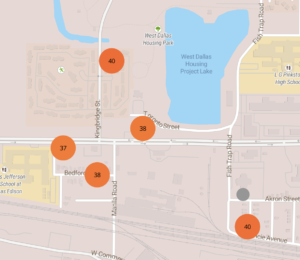 Public Health specializing in respiratory toxicology and environmental health warned, “If verified by EPA, these numbers are concerning. Exposure to levels over the EPA regulatory limits can lead to chronic diseases, such as heart disease, stroke, and premature death. The immune system, reproductive system, and developmental functions can also be harmed. The elderly, children, and infants are particularly vulnerable.”
Public Health specializing in respiratory toxicology and environmental health warned, “If verified by EPA, these numbers are concerning. Exposure to levels over the EPA regulatory limits can lead to chronic diseases, such as heart disease, stroke, and premature death. The immune system, reproductive system, and developmental functions can also be harmed. The elderly, children, and infants are particularly vulnerable.”
Janie Cisneros, who lives with her family just feet from GAF’s fence line and hosted one of the monitors said “I grew up on Bedford Street and GAF was always a big presence. Now that I moved back to raise my own family, I see how disgusting and unhealthy the air is. It often keeps me from playing with my daughter outside.”
This is the first time in Texas that new low-cost hyperlocal air monitoring by residents has revealed potential violations of a national air pollution standard. Despite years of complaints, there are no City of Dallas, State, or EPA monitors near GAF.
At the same moment GAF is being accused of creating hazardous levels of air pollution, a research of City Hall documents by staffers for the Southern Dallas Neighborhood Self Defense Project revealed that GAF doesn’t have a current Certificate of Occupancy or the Special Use Permit (SUP) from the City of Dallas it needs to be operating at the site.
The RSR smelter also never operated with the SUP it was required to obtain. More recently, the six-story dumping ground for the asphalt shingles that GAF and others produce, that became Shingle Mountain in Southern Dallas, was illegal from the first day it operated because it also lacked a required SUP and Certificate of Occupancy.
Armed with this new information, West Dallas residents notified the City of Dallas about GAF’s illegal status. WD1 representatives have been told the research is correct and the City is now investigating. Without the Special Use Permit, GAF’s shingle-making is a “non-conforming” use and the City could initiate the same proceedings it used to eventually close RSR.
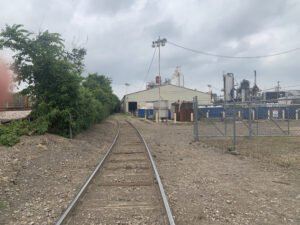 This dramatic news about GAF’s legal status and pollution levels comes precisely at the moment the company is applying for a renewal of its “Title V” operating permit from the State and EPA. Usually a mundane regulatory rubber-stamping, this process now has the potential to substantially add to the company’s headaches.
This dramatic news about GAF’s legal status and pollution levels comes precisely at the moment the company is applying for a renewal of its “Title V” operating permit from the State and EPA. Usually a mundane regulatory rubber-stamping, this process now has the potential to substantially add to the company’s headaches.
After months of requests by West Dallas 1 and elected officials, the Texas Commission on Environmental Quality (TCEQ) will be holding a virtual public hearing on the permit on July 29th at 7 pm.
Residents and others who want to ask questions or provide comments during the hearing may access the webcast by following this link:
https://www.gotomeeting.com/webinar/join-webinar
and entering 192-616-739 along with your email address or may call (512) 239-1201 at least one
day prior to the hearing for assistance in accessing the hearing and participating telephonically.
Members of the public who wish to only listen to the hearing may call, toll free, (415) 655-0060 and enter access code 569-744-316.TCEQ staff is recommending that you join and register at least 15 minutes before the hearing begins. A copy of the permit application can be viewed at the Dallas West Branch Library (2332 Singleton Boulevard). General complaints can be submitted in writing up to the hearing date to the TCEQ here:
https://www.tceq.texas.gov/assets/public/compliance/monops/complaints/complaints.html and objections to the permit renewal can be submitted here: http://www14.tceq.texas.gov/epic/eComment/.
Besides WD1, the groups lining-up to oppose the federal permit renewal are a combination of Dallas environmentalists, neighborhood associations, and social justice organizations, including Dallas Sierra Club, Downwinders at Risk, Public Citizen, and Southern Sector Rising.
After a review by TCEQ GAF’s permit renewal then heads to the Biden Administration’s EPA, which has pledged to work with communities of Color to reverse the kind of environmental racism the groups claim GAF is guilty of practicing.
“No permits. The wrong zoning. Dangerous levels of air pollution. Right in the middle of Black and Brown neighborhoods. Tell me how this ISN’T a repeat of the environmental racism West Dallas has been fighting for decades,” said Reyes. “We expect the Biden Administration to make good on its promise to end this kind of unacceptable discrimination.”
We Did This: A Shingle Mountain Clean-Up is Coming
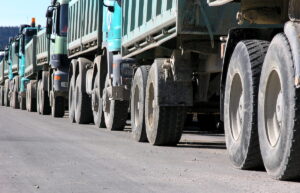
Despite the flurry of cynical and self-serving photo ops and press releases that Dallas City Hall churned out on Monday celebrating the beginning of a clean-up at Shingle Mountain, no waste was removed from the site yesterday. Nor will any be removed today.
But thanks to you, a clean up is coming. And also thanks to all you, that clean-up is suddenly more concerned with the health of Choate Street residents.
Last week, after a required 30-day public notice period, a state court approved a settlement between the illegal dump’s landowner, the State of Texas and the C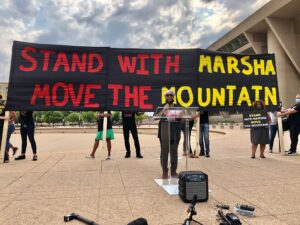 ity of Dallas that sets the table for removal of all “above ground” material. On Monday, contractors for the city were installing air monitors around the dump to record the levels of dust created when bulldozers begin loading the estimated 100,000 tons of hazardous waste into waiting 18-wheelers for the half mile trip to the McCommas landfill.
ity of Dallas that sets the table for removal of all “above ground” material. On Monday, contractors for the city were installing air monitors around the dump to record the levels of dust created when bulldozers begin loading the estimated 100,000 tons of hazardous waste into waiting 18-wheelers for the half mile trip to the McCommas landfill.
According to a separate agreement between the City and the landowner, the City has until December 25th to “begin” the removal process, i.e. sending trucks to actually haul off waste.
This result was anything but a foregone conclusion when the “Move the Mountain” campaign began last August 5th with a new conference at City Hall demanding the illegal dump be gone by the end of the year.
Only 4 months ago City Hall hadn’t made any commitments to a clean-up and had no estimate for when one would take place. The City Council had just unanimously rejected pleas from Choate Street residents to re-establish the Environmental Health Commission as part of a new Climate Plan. We were at a low ebb in our campaign.
But a strategic and constant barrage of public protest and shaming – mock trials, leafleting the Mayor’s law firm, 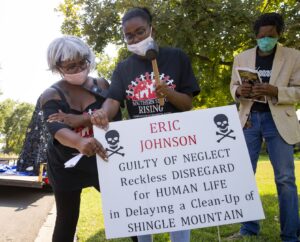 dumping waste at City Hall – along with the attendant embarrassing media coverage, made the City of Dallas actually commit itself to a clean-up it hadn’t planned on doing quite as fast, if at all.
dumping waste at City Hall – along with the attendant embarrassing media coverage, made the City of Dallas actually commit itself to a clean-up it hadn’t planned on doing quite as fast, if at all.
Keeping constant pressure applied for four months was often exhausting, but momentum grew with each new demonstration. November 16th might have seen “peak” Shingle Mountain coverage with publication of a long and well-written expose in the Washington Post, a public demonstration at the dump’s gate counting down the days until a clean-up was supposed to begin and a crew from Solodad OBrien’s upcoming BET documentary in town to film it for a premiere in February.
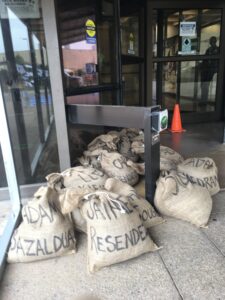 Thanks to everyone who showed up to those demonstrations of support. Whether you attended one or all of them, your presence made a difference.
Thanks to everyone who showed up to those demonstrations of support. Whether you attended one or all of them, your presence made a difference.
Those of you who sent in public comments this last month also had an impact. Initially, neither the State nor City expressed the least bit of concern about the health of Choate Street residents during the messy business of removing the waste. No specific provisions for controlling dust or monitoring air quality were included in the City agreement or State settlement.
But after over 50 letters and emails worth of comments were sent and included in the public record, the City suddenly got religion. It included dust control measures and air monitoring in its final description of the clean-up to the court. Lawyers for Marsha Jackson, Co-Chair of Southern Sector Rising, and a Downwinder board member cited your public comments as the reason the City included these new safeguards at the last minute. So congratulations a second time.
Now what?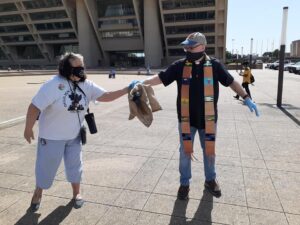
The settlement and agreements signed by the State and City are vague about what happens after the land surface is cleared of waste. Will there be any monitoring wells drilled to see if contamination seeped into the groundwater? Will the clean-up extend below the ground as well as above if the soil is contaminated? If pollution is found in the soil or water, what level of contamination is “acceptable”, i.e. what are the clean-up levels then?
And what and who will be responsible for the health costs -financial and physiological – accumulated by Ms. Jackson and the other Choate Street families?
Residents have drafted their own neighborhood plan for redevelopment that drastically changes the zoning in their community. They’ve submitted it to City Hall. But the same City Council Member that was taking unearned credit for Shingle Mountain’s removal on Monday is fighting this neighborhood plan tooth and nail.
District 8 City Council Member 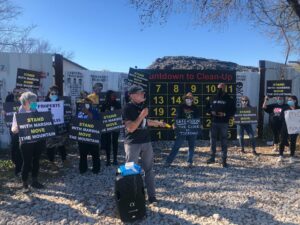 Tennell Atkins is one of the biggest reasons Shingle Mountain exists at all, and why its removal has been so delayed. He’s been nothing but an obstacle to be overcome instead of an ally for his constituents. Adding insult to injury, he’s now standing in the way of Choate Street and Flora Farms residents being able to rebuild their community from the devastation he’s inflicted on them.
Tennell Atkins is one of the biggest reasons Shingle Mountain exists at all, and why its removal has been so delayed. He’s been nothing but an obstacle to be overcome instead of an ally for his constituents. Adding insult to injury, he’s now standing in the way of Choate Street and Flora Farms residents being able to rebuild their community from the devastation he’s inflicted on them.
Atkins is up for re-election in May and it’s our hope that all of you who made this Shingle Mountain clean-up happen will stick around and finish the job by helping us remove this political tumor that threatens the future of Southern Dallas.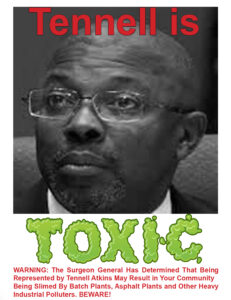
Sunday December 13th was the two-year anniversary of the very first Robert Wilonsky column about Shingle Mountain in the Dallas Morning News. Some of us believed that first column would expose the problem and move officials to act to resolve it. 13 Wilonsky Shingle Mountain columns later, we’re still waiting on the trucks that should have arrived in January 2019.
If they show up before Christmas Day , it will be one of the best, most satisfying moments of a terrible year. But it won’t be the end of the struggle over racist zoning that began on Choate Street. That struggle is just beginning.
Send Your Public Comments for a SAFE Shingle Mountain Clean-Up
What:
Public Comments on the State’s Settlement with Shingle Mountain landowner
When:
Now thru Sunday, Dec 6th
How:
Use our ClickNSend email feature to send your comments to Texas Attorney General’s office in 90 seconds
Why:
To make sure residents’ health is protected during a Shingle Mountain clean-up

A four-month citizens’ campaign pressuring the City of Dallas to clean-up the Shingle Mountain illegal dump in Southern Dallas by the end of 2020 is on the verge of paying off.
Following a pattern that began in summer, on the very same October day groups planning civil disobedience at the dump site announced another action, the City signed an agreement with the Shingle Mountain landowner to take responsibility to “begin” a clean-up by Dec 25th. In return, the City received a check for $1 million from the landowner.
Meanwhile, the state has also reached an agreement with the landowner that clears the way for a clean-up. That agreement is now up for public comment until 12 Midnight Sunday, December 5th.
You can help us protect the health of the Choate Street families most affected by the clean-up by providing your public comments to this State agreement. Doing so sends a message to both Austin and Dallas City Hall that they’re being held accountable now that they’ve been put in charge of removing the 100,000 tons of illegal hazardous waste they helped create.
Public pressure is what’s brought us to this point. Public pressure must now 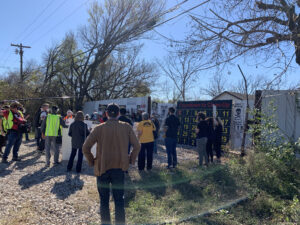 make sure the clean-up itself won’t increase residents’ exposure to hazardous materials like Silica, Formaldehyde, Petroleum By-Products and exotic glues and adhesives used to make shingles that are now crumbling into tons of microscopic particles.
make sure the clean-up itself won’t increase residents’ exposure to hazardous materials like Silica, Formaldehyde, Petroleum By-Products and exotic glues and adhesives used to make shingles that are now crumbling into tons of microscopic particles.
On Monday November 16th, members of Southern Sector Rising, Downwinders at Risk, Southern Dallas Shingle Movers and other protesters gathered at the d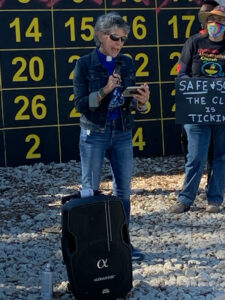 ump’s front gate for an action that hoisted and hooked a huge Clean-Up Countdown Calendar onto the eight-foot-tall metal fence that divides the site from South Central Expressway.
ump’s front gate for an action that hoisted and hooked a huge Clean-Up Countdown Calendar onto the eight-foot-tall metal fence that divides the site from South Central Expressway.
Designed as a giant-size desk calendar, it marked the 30 days of public notice ending on Sunday the 6th. Rev. Frederick Haynes of Friendship-West Baptist Church, Rabbi Nancy Kasten, and the Rev. Amy Moore joined Marsha Jackson and her neighbo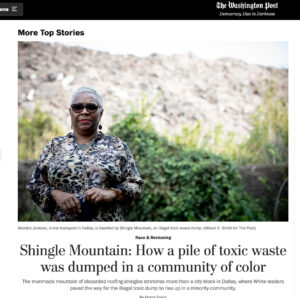 rs in speaking about the need to monitor the City and State during this critical phase.
rs in speaking about the need to monitor the City and State during this critical phase.
On the same day, a lengthy expose on Shingle Mountain by Washington Post national climate and environmental reporter Darryl Fears instantly made the dump a national poster child for Environmental Racism.
Two days later, Dallas Mayor Eric Johnson was asked about the Shingle Mountain clean-up by a Channel 8 reporter during his City Hall press conference on rising crime rates in Dallas. His revealing answer beginning with, “It’s really a legal problem,” confirmed the City always had the option of cleaning up the dump, but delayed doing so for over 18 months until it had received money from either the operators or landowners. Admitting that the City could have “solved” this problem early on, Johnson said the City choose not to because that would have made the City’s lawsuit against the landowners “moot.”
Moot is a lawyer’s term that’s defined as “of little or no practical value, meaning, or relevance; purely academic.” Instead of making their lawsuit moot by immediately cleaning up a site causing daily human health damage, Mayor Johnson and the City of Dallas rendered the health of Marsha Jackson and the Choate Street families moot. They made it of little or no practical value in the City’s approach. Of much greater value was the cash received by the landowners. The City sacrificed a street full of its own residents for a lousy $1 million.
In his three-m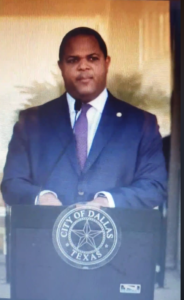 inute response, Johnson never uttered Marsha Jackson’s name, never addressed residents’ health issues, and never expressed regret, second thoughts, or apologies over the year and half the six-story waste pile harmed Choate Street residents. He never admitted the City’s multiple failures in code enforcement, zoning or environmental regulation that paved the way for Shingle Mountain’s creation. He complained how the City was put in a “tough position” – never considering how tough it might be for parents to watch helplessly as their child coughs-up pieces of ground-up shingles. Mayor’s Johnson’s answer was full of legal rationale but completely devoid of humanity or self-awareness. There were no people in it.
inute response, Johnson never uttered Marsha Jackson’s name, never addressed residents’ health issues, and never expressed regret, second thoughts, or apologies over the year and half the six-story waste pile harmed Choate Street residents. He never admitted the City’s multiple failures in code enforcement, zoning or environmental regulation that paved the way for Shingle Mountain’s creation. He complained how the City was put in a “tough position” – never considering how tough it might be for parents to watch helplessly as their child coughs-up pieces of ground-up shingles. Mayor’s Johnson’s answer was full of legal rationale but completely devoid of humanity or self-awareness. There were no people in it.
In short, it was an articulate if soulless synopsis of the City’s position regarding not only Shingle Mountain, but all environmental health problems in Dallas. Because at Dallas City Hall there is no such thing as human-centric environmental problems. What was the City’s first legal response to Shingle Mountain? It wasn’t to cite what an illegal awful abomination it was, but to take it to court over storm water violations. There were no people to worry about. Besides the inability of the City to protect its own residents from illegal hazards is the fact that it continues to treat Choate Street residents as spectators to their own disaster. Marsha Jackson is the Invisible Woman.
In May the Dallas City Council unanimously rejected the pleas of Ms. Jackson and Southern Sector Rising to re-establish the Dallas Environmental Health Commission to give an institutional voice to their concerns within City Hall; to put people back into the mix along with tree planting and water conservation. The Council turned its back on her – again.
That’s why your public comments about maintaining the safety of the pending clean-up are important.
Please show the City of Dallas that you care about Marsha Jackson and the families on Choate Street – even if it doesn’t. Thanks.
CLICK HERE TO SUBMIT YOUR COMMENTS
Robert Wood Johnson Foundation awards grant to Texas A&M and Downwinders at Risk for Joppa Environmental Health Project
Monies will fund unprecedented study of link between health and air pollution in Dallas Freedman’s Town; first effort of its kind in Texas
What’s believed to be the single largest environmental health research investment in a Texas neighborhood was awarded today by the Robert Wood Johnson Foundation to examine the links between human health and air pollution in the Joppa community of Dallas.
 Texas A&M and Downwinders at Risk’s Joppa Environmental Health Project was selected as one of only 16 national proposals funded by the Foundation’s Interdisciplinary Research Leaders grant. Between now and 2022, over $350,000 will be spent by Texas A&M scientists trying to understand the correlation between Particulate Matter air pollution and the health of the Freedman’s Town’s residents.
Texas A&M and Downwinders at Risk’s Joppa Environmental Health Project was selected as one of only 16 national proposals funded by the Foundation’s Interdisciplinary Research Leaders grant. Between now and 2022, over $350,000 will be spent by Texas A&M scientists trying to understand the correlation between Particulate Matter air pollution and the health of the Freedman’s Town’s residents.
Cecilia Wagonner, a member of the Joppa church that hosted a community meeting on air pollution monitoring last December, was enthusiastic about the news. “I want to know the truth and nothing but the truth about air quality in our historic neighborhood. This is definitely good news. Let environmental justice be served.”
Per capita, Joppa is the most polluted neighborhood in Dallas. On one side is the Trinity River. On the other three sides are an asphalt batch plant, Railroad switch yard, large asphalt shingle factory, a concrete batch plant, and Interstate highway. It’s directly downwind from the largest methane air p olluter in Dallas – the City’s McCommas Landfill methane energy recovery unit.
olluter in Dallas – the City’s McCommas Landfill methane energy recovery unit.
Since PM air pollution monitoring began there on August 31st as part of the new SharedAirDFW air monitoring network, Joppa’s PM levels have averaged significantly higher than other sites.
Two Texas A&M scientists based in College Station will lead the new Project. Dr. Natalie Johnson, is an A&M toxicologist specializing in the health effects of Particulate Matter air pollution, and Dr. Ping Ma, is an A&M behavioral and social science researcher who previously worked at Dallas Children’s Hospital specializing in health disparities and social determiners of health. Downwinders will assist with community canvassing and outreach efforts as well as provide technical support through its 11-Joppa based SharedAirDFW network monitors.
They’re now all charged with collecting evidence to discover whether Joppa has higher rates of PM air pollution and health problems than other communities, and understand how differences in daily levels of PM affect residents’ health.
“PM represents a significant ‘unseen’ health risk related to cardiovascular disease, chronic respiratory disease, including lung cancer and asthma, as well as effects on infant development and brain health,” said Johnson. “SharedAirDFW’s real-time pollution monitors will help make this threat ‘seen.”
Ping pointed out the study will be the first academic-community collaboration of its type in Texas. “Our findings will facilitate understanding of the air pollution risks Joppa residents face as well as generate community-based solutions to help create a new culture of environmental health in Joppa.”
Participa nts chosen for the IRL process also become students who receive training in the latest research methods and constant feedback from panels of experienced scientists and experts.
nts chosen for the IRL process also become students who receive training in the latest research methods and constant feedback from panels of experienced scientists and experts.
Grant monies will pay for staff time, graduate assistants, technology, travel, and community outreach over a three-year period.

The IRL grant is the first research project attracted by the SharedAirDFW regional air monitoring network that debuted in September, but Jim Schermbeck, Director of Downwinders, predicted it wouldn’t be the last. “This network makes all kinds of new comparisons and studies possible. In this case, residents and researchers are using it to document Joppa’s air pollution burdens and assist residents in relieving those burdens. That’s a first for Dallas, and Texas.”
From now until the end of the year the Project partners will be assembling their local contacts, refining their timeline and methodology, and getting ready to begin research in early 2021.
Help us Move Shingle Mountain



Choate Street families in Southern Dallas, including this child, and Ms. Marsha Jackson (pictured above) are still living under 100,000 plus tons of hazardous waste that was illegally dumped without their knowledge or consent.
It’s been almost three years since dumping began and two since the residents forced the dumping to stop, but the Mountain still remains, causing respiratory and neurological health problems for everyone on the street.
Shingle Mountain remains despite the City of Dallas having the legal authority and money to remove it. The City has had both for the entire three-year existence of the dump but has chosen to delay a clean-up in order to try to get the original operators to pay for it. That’s hasn’t happened.
On August 5th an alliance of over 30 groups, including Downwinders, sent a letter to the Dallas City Council and City Manager stating that if the City did not begin removing Shingle Mountain by October 1st, they would begin to do it themselves.
 On August 29th, many of those same groups participated in the Shingle Mountain Accountability Convoy, a mobile four hour protest that saw the conviction of five elected officials for “reckless disregard for human life” in mock trials with the Shingle Mountain float as a centerpiece.
On August 29th, many of those same groups participated in the Shingle Mountain Accountability Convoy, a mobile four hour protest that saw the conviction of five elected officials for “reckless disregard for human life” in mock trials with the Shingle Mountain float as a centerpiece.
10 days later the City put out a bid request for the job of removing the waste from Shingle Mountain. That process is over on October 5th. Despite this positive development the Dallas City Manager stated THIS WEEK that it would still be 2-3 months before an actual clean-up began.
THAT IS UNACCEPTABLE.
Downwinders and other groups are asking you to help respond to this continued delay in TWO ways:
1) CLICK HERE to send an email message to the Dallas City Council that says “Move the Mountain Now!”

It’s already written and addressed at our website’s “Featured Citizen Action” – all you have to do is fill in your contact information and click and away it goes. You can add your own message if you like as well.You may not be able to do much else right now, but you can send an email on behalf of these families.
2) Attend the Shingle Mountain Non-Violent Civil Disobedience training session This SUNDAY 2-5 pm

For the first time in our 26-year history we’re endorsing civil disobedience and training people who want to put themselves at risk of arrest on behalf of the Shingle Mountain families and those that want to support them when they do.
Last Sunday was our first training session. It attracted 20 people. We’re hosting another training session THIS SUNDAY 2-5 pm in Dallas at the GoodWorks
Co-Working space where Downwinders is headquartered. Masks are required and social distancing will be enforced. Training will occur outside.
In 2019, the threat of civil disobedience by Choate Street residents and their supporters was the only thing that got the City of Dallas to change its mind and close down active operations at Shingle Mountain. After another year of trying to
clean-up this on-going disaster with meetings, we’re tired of the City’s willful neglect and cruel delay that’s harming human health. We need to again show we’re willing to go to the mat for this outrage.
You don’t have to be sure you want to risk arrest. You just have to want to help. Support roles for those getting arrested are critical. Whether you want to risk arrest or provide support you must have this training.
Just having more names on this list will send the City an important message. Please consider showing up and adding yours. Thanks.
Joppa Air Monitor Already Providing Evidence of Why It’s Needed
Since it began collecting data on the afternoon of August 31st, the Joppa Zion Mothership monitor has consistently recorded the highest average levels of PM among all the deployed SharedAirDFW monitors, as well as all EPA and Purple Air monitors in DFW. These bar charts show the level of PM recorded from most of the current SharedAirDFW network monitors from 8/31/20 to 9/14/20. They’re all accessible to the public through the site.

A New Era for DFW Air Quality and Downwinders at Risk
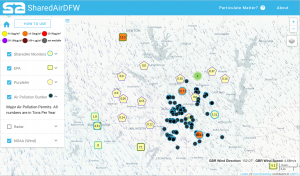
The SharedAirDFW network map displaying monitors from all three monitor networks and major Dallas air polluters identified.
The debut of the SharedAirDFW Network means
21st Century air monitoring finally arrives in North Texas
After three years, and many thousands of hours and dollars, citizens have their own
regional air quality monitoring system.
It’s easy to use, operates in real time, and its monitors are being put where the pollution burdens are greatest.
The Joppa Zion Mothership Monitor: on the Network’s digital map and on its pole after deployment.
Since operation began 8/31, it’s consistently shown higher levels of PM air pollution than other monitors in Dallas.
By January they’ll be 11 more monitors joining it in the Freedman-founded community.
A three-year high-tech collaboration between the University of Texas at Dallas, Downwinders at Risk, the City of Plano, Dallas County, Dallas College, and Paul Quinn College came to fruition today with the official debut of the the SharedAirDFW Network – online, and with an outpost in one of the most polluted neighborhoods in North Texas.
It becomes the first and only regional “hyper-local” air monitoring network in Texas and one of the only ones being built by any US city.
“This network is the purest, most dramatic expression of our 26-year old goal to provide citizens with the tools government won’t,” said Downwinders Director Jim Schermbeck, who’s helped shepherd the Network since it was a National Science Foundation grant runner-up in 2017. “We see SharedAirDFW’s debut as the public health equivalent of turning on electric streetlights for the first time at the turn of the 20th Century. We’re building a utility – the full impact of which won’t be realized for years.”

Dave Dabadeen, Kevin Owen, and Jay Smith – our monitor installation team, deploying one of 11 solar powered satellite monitors in Joppa.
Debuting with eight Particulate Matter (PM) air pollution monitors located from Richardson to Southern Dallas and Mesquite to Fort Worth, the network is scheduled to install over 100 more in the next 12-24 months, including blanketing Dallas neighborhoods whose residents say they’re already breathing bad air but have no way to prove it.
In the last decade published research on the human health effects of exposure to Particulate Matter air pollution has linked it to a variety of illnesses and diseases, including developmental impacts such as Autism, Parkinson’s, Dementia, and IQ loss. These effects have been documented at exposure levels well below U.S. EPA regulatory limits.
All the monitors in the network were built at the Physics Laboratory at the University of Texas at Dallas campus in Richardson. They’re being distributed to members either in clusters of 11, with one larger hard-wired “Mothership” accompanying ten smaller solar-powered ones or the Mothership as its own stand alone unit.
ALL DFW PM MONITORS DISPLAYED ON A SINGLE MAP
PM Air pollution data collected from those monitors, along with information from EPA and DFW Purple Air monitors, are displayed in real time on a digital map accessible to anyone online at www.sharedairdfw.com. For the first time, a single website displays all the online monitors networks collecting PM air pollution data in North Texas on the same map. Besides UTD, Downwinders at Risk, Dallas College, and Dallas County will be displaying the SharedairDFW map on their own websites.
Only Particulate Matter air pollution levels are shown by the SharedAirDFW map now but larger monitors will also be capturing Ozone, or Smog levels. At some point in the near future, that data will also begin to be displayed on the Network map.
MAPPING OF MAJOR POLLUTERS
Also on display are the locations of the major air polluters in the City of Dallas, along with their self-reported pollution volumes – a first-ever inventory of Big D’s air polluters that no level of government currently provides.
MANY MORE M ONITORS IN MANY MORE PLACES
ONITORS IN MANY MORE PLACES
Currently there are only six EPA monitors for Particulate Matter Air pollution in all of North Texas, and only 12 Purple Air monitors online. With the ability to saturate neighborhoods with almost a dozen monitors apiece, SharedAirDFW allows residents, researchers, and policymakers to better pinpoint pollution plumes and health risks.
REAL TIME DATA
For the first time there’s a way for DFW residents get air quality information in real time instead of waiting for up to two or three hours at government monitor sites. The SharedAirDFW monitors display their readings every 30 seconds, 24 hours a day.
AN EMPHASIS ON ENVIRONMENTAL JUSTICE
For the first time there’s year-round, calibrated air quality data being collected in Dallas’ most polluted neighborhood – the Joppa community in Southern Dallas along the Trinity River. The “Joppa Zion Mothership” – named for the adjacent Church – began transmitting on Monday August 31st. It’s linked to two additional “satellite” monitors that began transmitting this last weekend. By January they’ll be 11 monitors in Joppa, making it the most densely monitored neighborhood not just in Dallas, but all of Texas.
Joppa’s monitors are the first of 33 air monitors Downwinders at Rik is deploying in so-called “fence line” locations. After installation in Joppa is completed, another 11 will be installed in West Dallas, and then in and around Midlothian as well.
In the two weeks since the first Joppa monitor was installed, it’s consistently recorded higher levels of PM pollution than other monitors in the SharedAirDFW network as well as local EPA and Purple Air monitors. Schermbeck said those results vindicate the decision to locate monitors in predominantly Black and Brown neighborhoods disproportionately burdened by their proximity to industrial polluters. “Our monitors are going where people are most harmed by air pollution, but least able to do something about it.”
National Fund Spotlights Downwinders’ Efforts to “Take Back Our Cities”
Today, the Peace Development Fund is using its national presence and contacts to help raise funding for Downwinders at Risk, under the banner of “Taking Back our Cities.”
We’re being featured on their website all day. We’re one of only 13 groups chosen to receive this kind of attention from the Fund.
The Fund liked our work around the upcoming Dallas MasterPlan process, partnering with Southern Sector rising and neighborhood groups to rezone Southern Dallas communities tract-by-tract to improve environmental health.
We’re one of the few environmental groups in the country using land use planning tools to reduce residents’ exposure to pollution. Our aim is to dismantle the racism institutionalized in local zoning codes that have forced People of Color and industry to live side-by-side for decades.
Many of you helped us reach our Giving Day goal. But we need those of you who didn’t contribute on Giving Day to do your part today. Here’s your chance to join the fight for cleaner air and environmental justice.
Thanks.
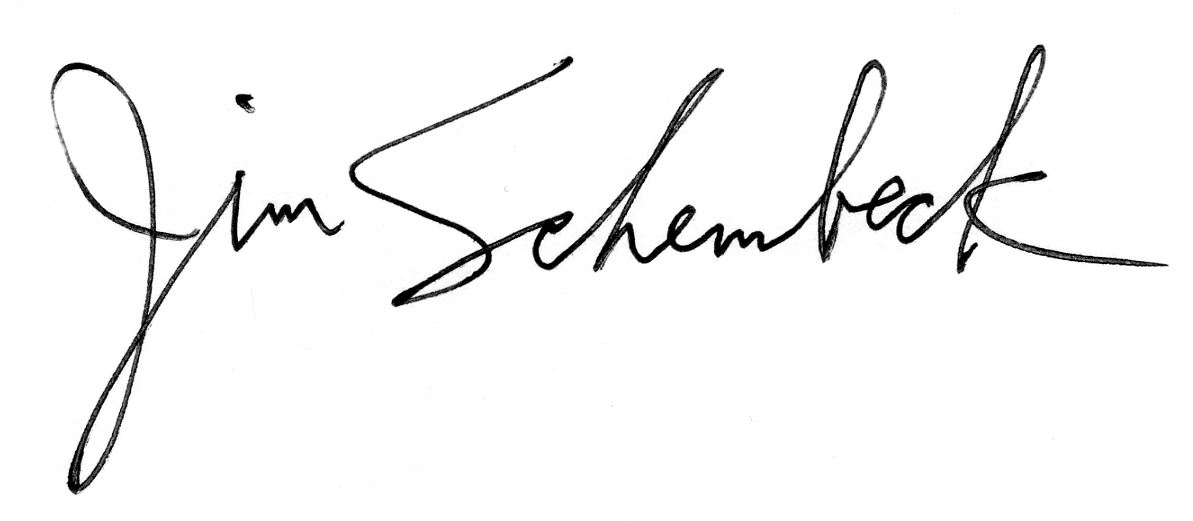
Director

____________________________________
COVID Connects:
Racist Zoning
to
Increased Vulnerability to COVID
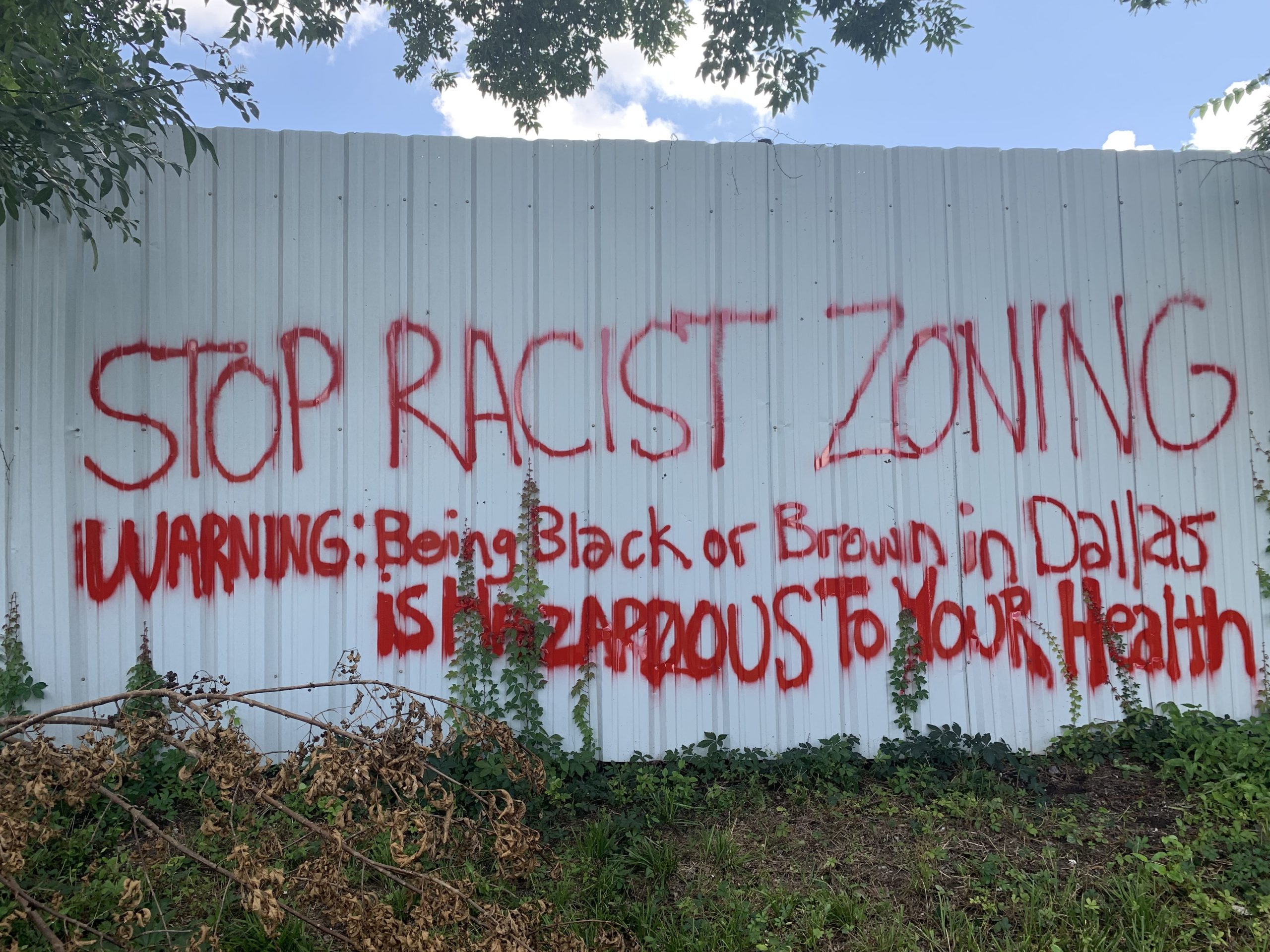
What is It?
For most people, “zoning” isn’t a very interesting topic. How your property is classified by city government is of little concern – until you discover how few protections you have or how close a large polluter can operate near you.
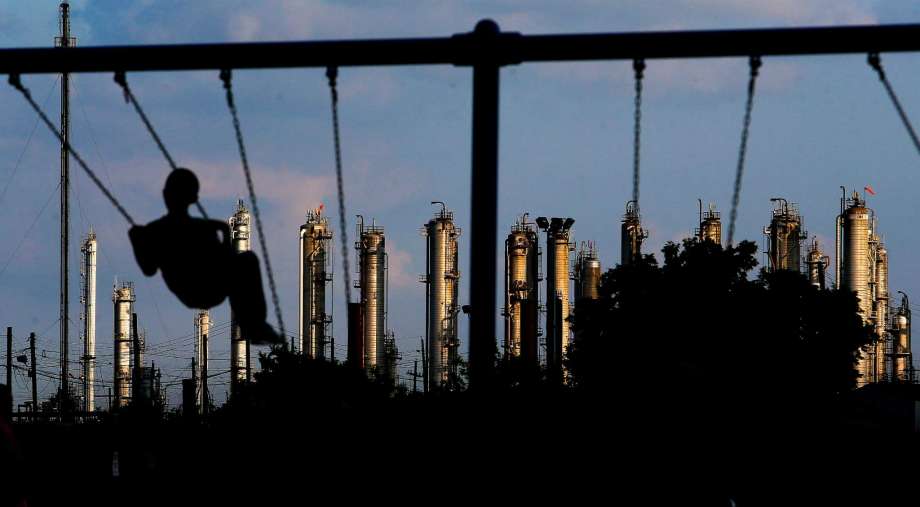 In Dallas as well as most American cities, People of Color have been historically forced by law or practice to live in neighborhoods they had to share with industry. The Trinity River floodplains were used as a large dumping ground for both people and factories deemed “undesirable” by white power brokers.
In Dallas as well as most American cities, People of Color have been historically forced by law or practice to live in neighborhoods they had to share with industry. The Trinity River floodplains were used as a large dumping ground for both people and factories deemed “undesirable” by white power brokers.
While illegal now, that institutionalized discrimination lives on in the form of obsolete racist zoning that still makes Southern Dallas a dumping ground.
Why Do It?
Unless you change the zoning classifications in South Dallas that make it such a haven for dirty industry, the City’s pollution burden will remain concentrated there, stifling economic development and quality of life.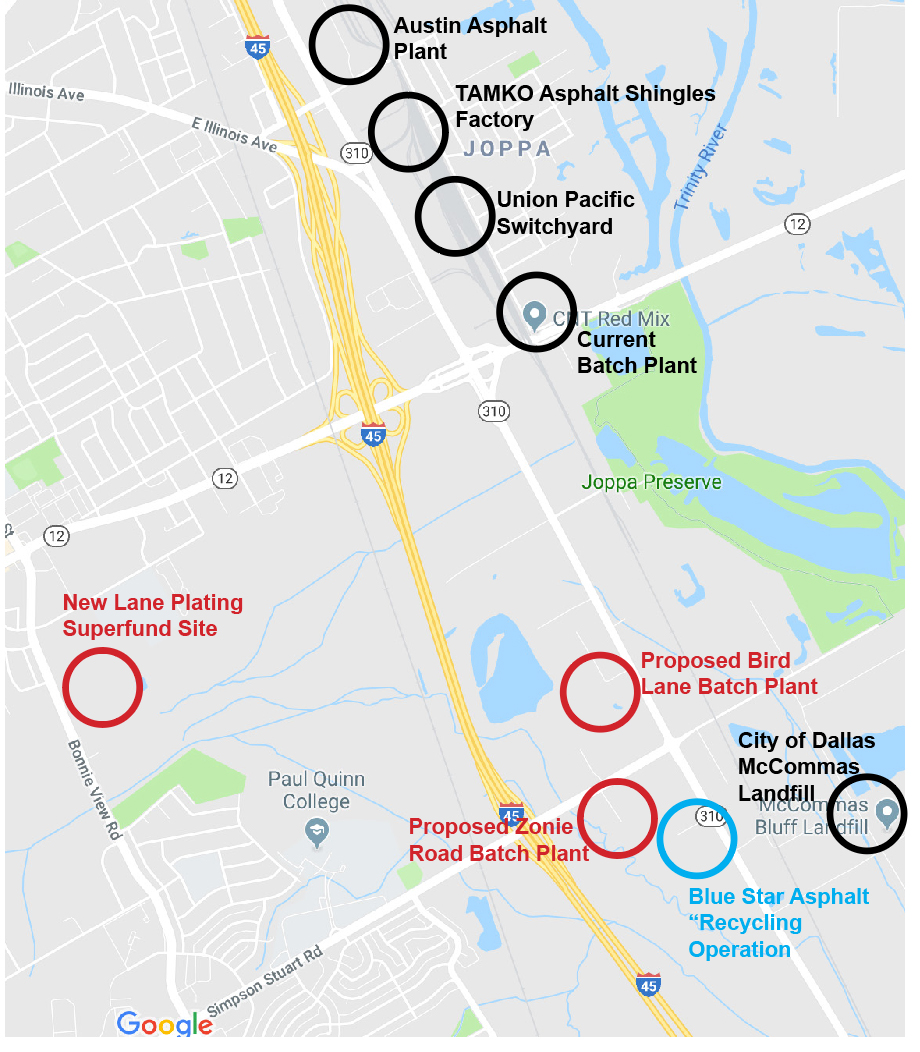 During the last two years Southern Dallas has fought off four proposed batch plants in the same neighborhood because the zoning directs them there. The notorious Shingle Mountain illegal dump took advantage of zoning loopholes to withhold notification of its activities from its neighbors. Instead of playing “whack-a-mole” and having to organize anew against every attempt to site a new polluter there, Southern Dallas residents need to re-write the leftover racist zoning laws and prohibit their part of town from becoming the default Big D dumping ground.
During the last two years Southern Dallas has fought off four proposed batch plants in the same neighborhood because the zoning directs them there. The notorious Shingle Mountain illegal dump took advantage of zoning loopholes to withhold notification of its activities from its neighbors. Instead of playing “whack-a-mole” and having to organize anew against every attempt to site a new polluter there, Southern Dallas residents need to re-write the leftover racist zoning laws and prohibit their part of town from becoming the default Big D dumping ground.
Downwinders is partnering with our friends at Southern Sector Rising and the Inclusive Communities Project to do just that. Dallas is gearing up for a once-in-a-decade review of the City’s MasterPlan that will invite residents to imagine how they want to change their neighborhoods. There’s an opportunity to submit new plans that reverse the racist zoning that plagues the entire Southern part of Dallas.
We’re working with specific Southern Dallas neighborhoods that want to give residents more green space, more buffer zones between themselves and pollution, and even begin proceedings to remove industry from their communities. It’s a 2-3 year process but the end result is increased Environmental Justice in places that desperately need it.
What’s the COVID
Connection?
Bottom: COVID Risk Factors
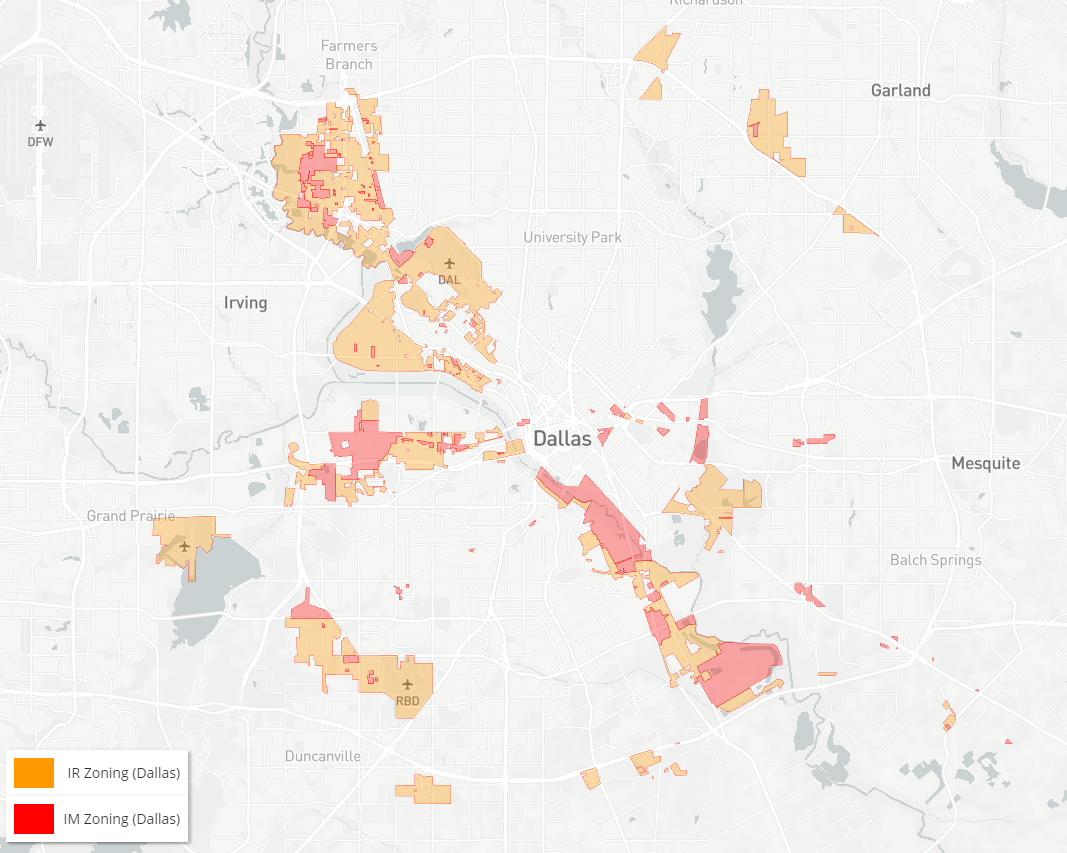 Research done during this pandemic shows Black and Brown residents are being disproportionatey impacted by the COVIC virus.This is being attributed to a number of “pre-existing conditions” in the neighborhoods where they live, including lack of health insurance and health care facilities, poverty and…exposure to air pollution. We know that Black and Brown residents are more likely to be exposed to more and higher levels of air pollution than their white peers.
Research done during this pandemic shows Black and Brown residents are being disproportionatey impacted by the COVIC virus.This is being attributed to a number of “pre-existing conditions” in the neighborhoods where they live, including lack of health insurance and health care facilities, poverty and…exposure to air pollution. We know that Black and Brown residents are more likely to be exposed to more and higher levels of air pollution than their white peers.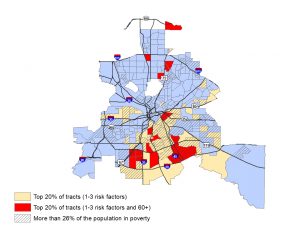 If you change the zoning so that Southern Dallas residents are not living side-by-side with polluters, you reduce their exposure to poisons and improve public health, including making them less vulnerable to viruses like COVID.
If you change the zoning so that Southern Dallas residents are not living side-by-side with polluters, you reduce their exposure to poisons and improve public health, including making them less vulnerable to viruses like COVID.
STATUS?
“forwardDallas!” is the name of the process the City of Dallas is using to redraw its MasterPlan. It was supposed to begin this Spring but may not start until summer. It will involve lots and lots of neighborhood meetings.Downwinders, Southern Sector Rising and the Inclusive 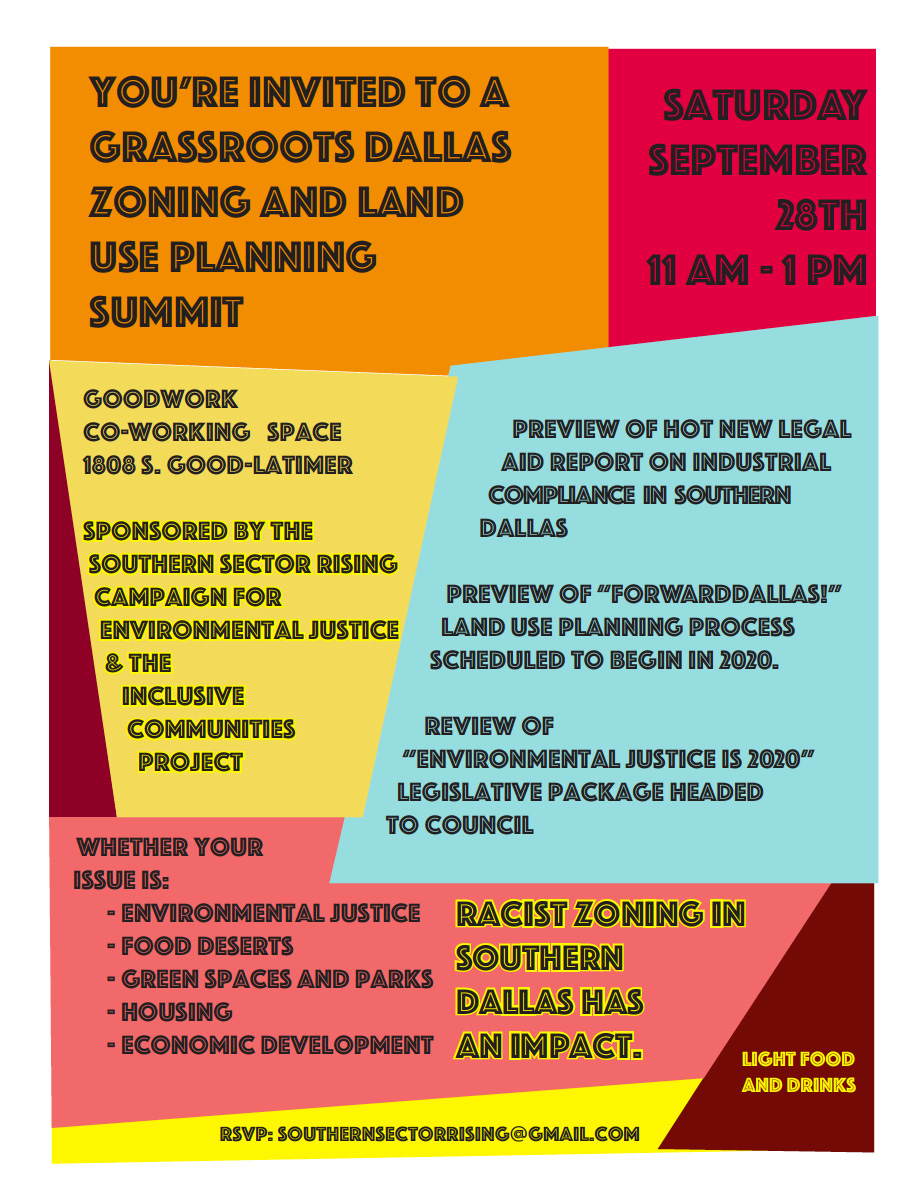 Communities Project isn’t waiting however. We’ve already met with residents’ groups in the Floral Farms and Fruitdale neighborhoods to begin a grassroots planning process. Because of their preparation, these groups will be able to show up to the City meetings with their own plans already developed and ready to be approved. More online meetings are being scheduled for other neighborhoods.
Communities Project isn’t waiting however. We’ve already met with residents’ groups in the Floral Farms and Fruitdale neighborhoods to begin a grassroots planning process. Because of their preparation, these groups will be able to show up to the City meetings with their own plans already developed and ready to be approved. More online meetings are being scheduled for other neighborhoods.
No group has used the “forwardDallas” process to overhaul Dallas zoning in such a comprehensive way. No coordinated effort has ever been focused on this mission. Like so many projects Downwinders takes on, its a “first.” But it’s a chance to make fundamental Change.
This obsolete pattern of “redlining” and segregation lives on in a legacy of racist zoning that still drives polluters to Southern Dallas and along the Trinity River Corridor. Most of the land set aside for heavy industry in Dallas is still south of the River – in predominantly Black and Brown neighborhoods like West Dallas and Joppa.
To make sure Southern Dallas doesn’t remain the City’s dumping ground you have to change the zoning that controls what can go where and next to whom.
PM Pollution and COVID
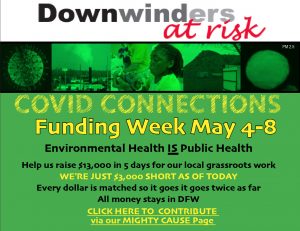
The Massachusetts-based Peace Development Fund has chosen to spotlight the COVID-connected work of
Downwinders at Risk and 12 other groups
across the country this week in order to help raise funds for that work.
As of late last night successfully met our original goal of $10,000. THANK YOU. So now we’re setting our sights on trying to raise an additional $3,000 by Friday. All of this money goes to local DFW program work in front line communities that are most vulnerable to
COVID infection.
Help us help more people.
CONTRIBUTE HERE
Thanks
______________________________________
COVID Connects:
Particulate Matter Air Pollution
to Increased Risk of Disease
What is It?
You’ve heard of the dangers of second-hand smoke? PM is industrial second-hand smoke.
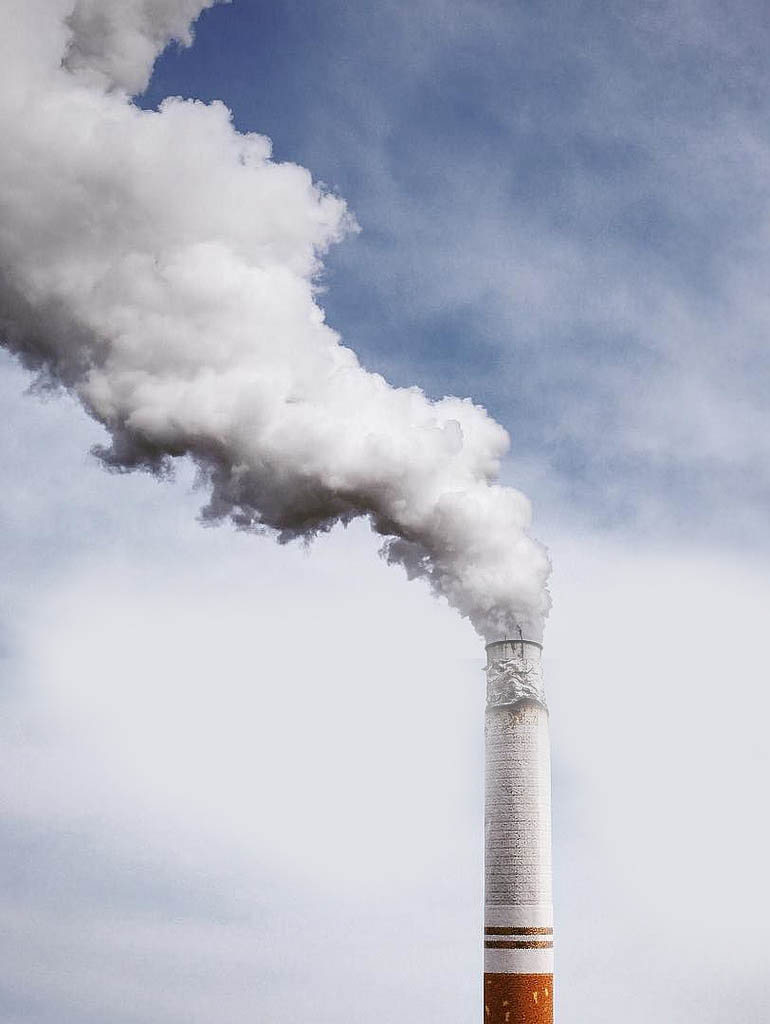 Research over the last decade connects PM pollution with not just lung and coronary diseases, but IQ loss, Autism, Dementia, Parkinson’s Disease, Diabetes, Immune-Deficiency, depression, and blindness. Research also shows Black and Brown residents are exposed to more PM pollution and at higher levels than most of their white peers.
Research over the last decade connects PM pollution with not just lung and coronary diseases, but IQ loss, Autism, Dementia, Parkinson’s Disease, Diabetes, Immune-Deficiency, depression, and blindness. Research also shows Black and Brown residents are exposed to more PM pollution and at higher levels than most of their white peers.re-thinking freeways. We’re in the weeds with neighborhood groups plotting new land use plans separating PM sources from people, or eliminating them altogether. In essence, we’re conducting an anti-smoking campaign aimed at machines.
Why Do It?
Sources of PM pollution are controlled by local gov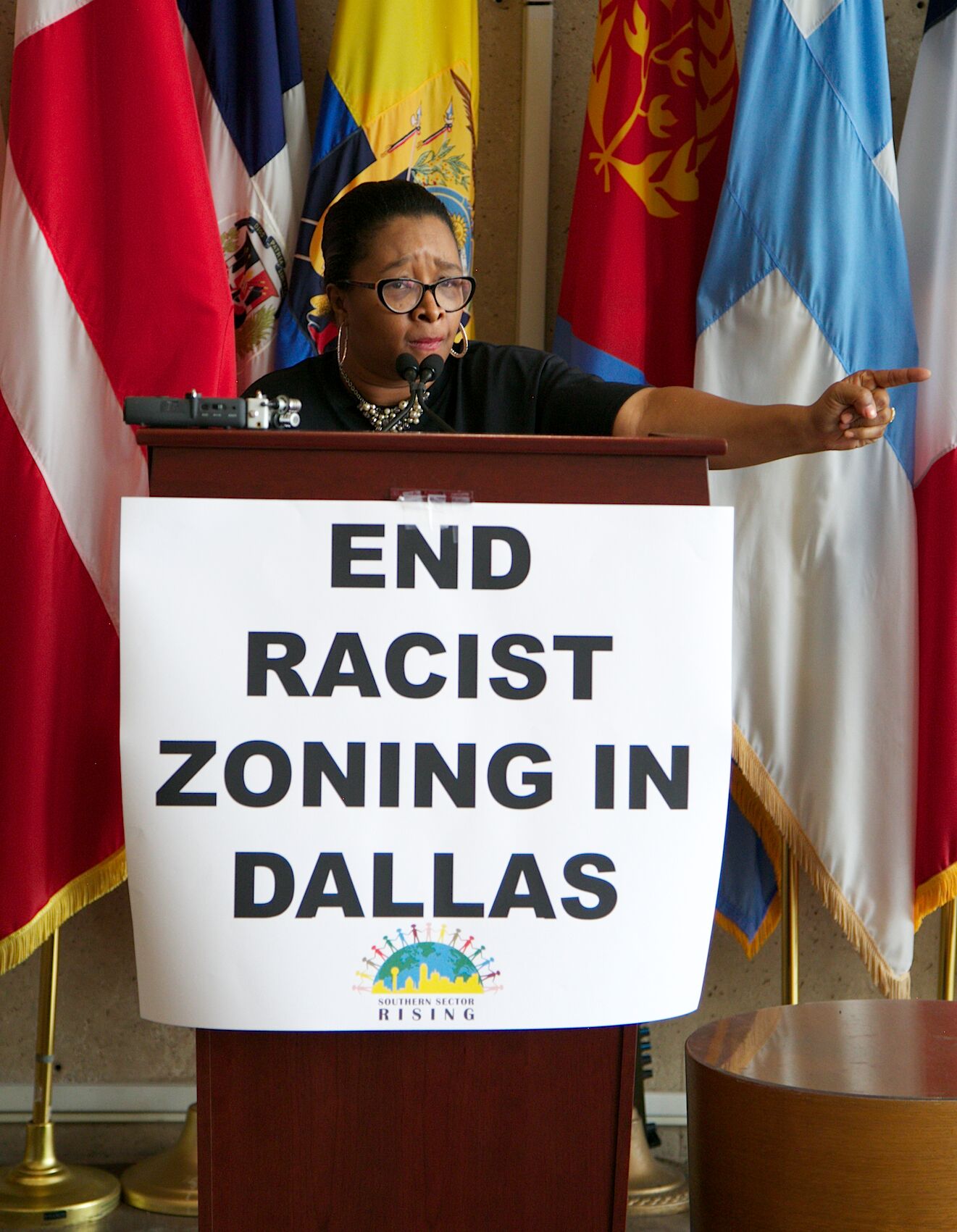 ernments through zoning and other municipal and county policies. As a local group, North Texas is where Downwinders is most effective in making change.
ernments through zoning and other municipal and county policies. As a local group, North Texas is where Downwinders is most effective in making change.
After the 2016 presidential election it was clear we couldn’t make progress on DFW chronic smog without good faith partners at EPA. So we turned our attention to addressing the most insidious air pollutant that can be controlled by local action. We found we could have a big impact on how these very small toxic particles are affecting DFW residents.
What’s the COVID Connection?
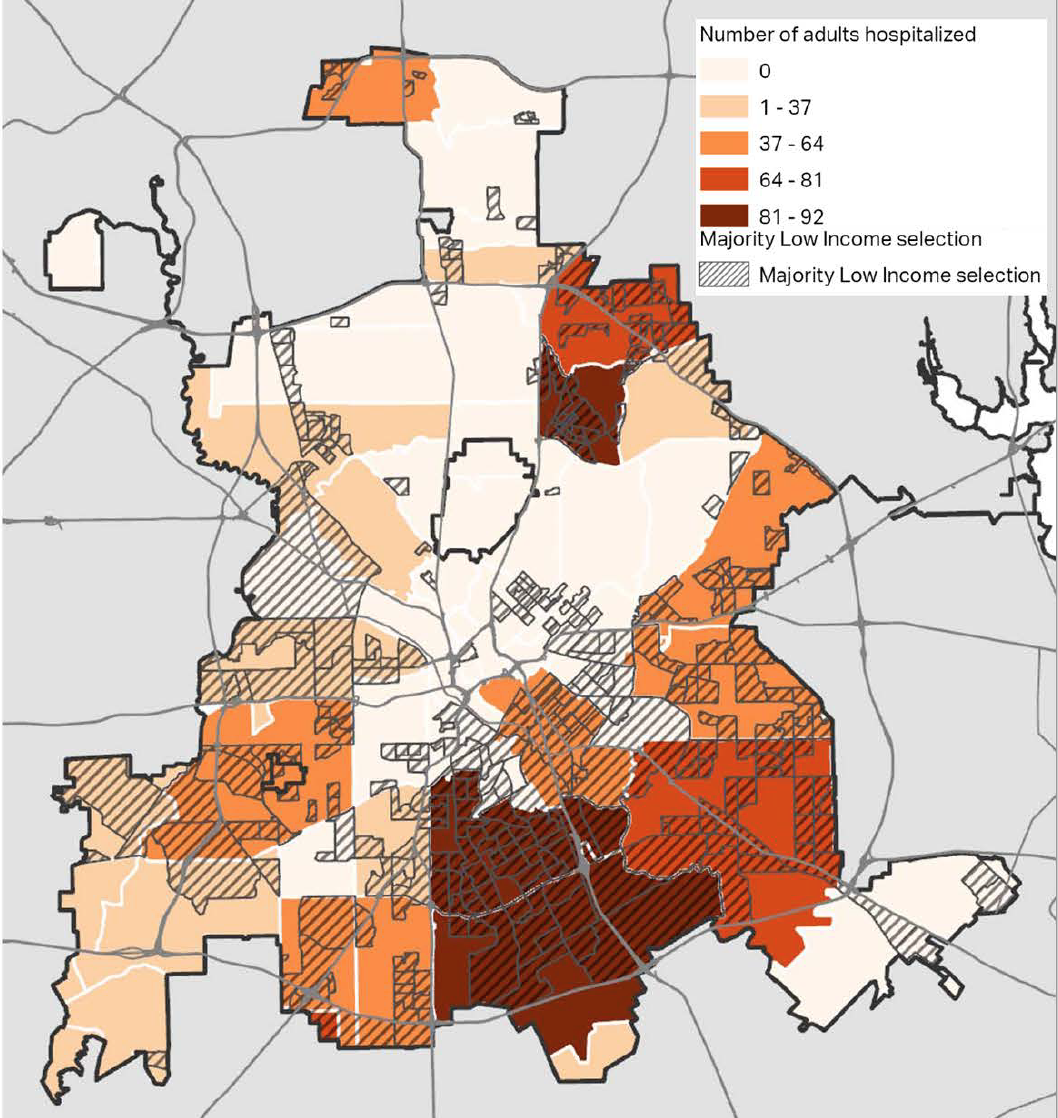
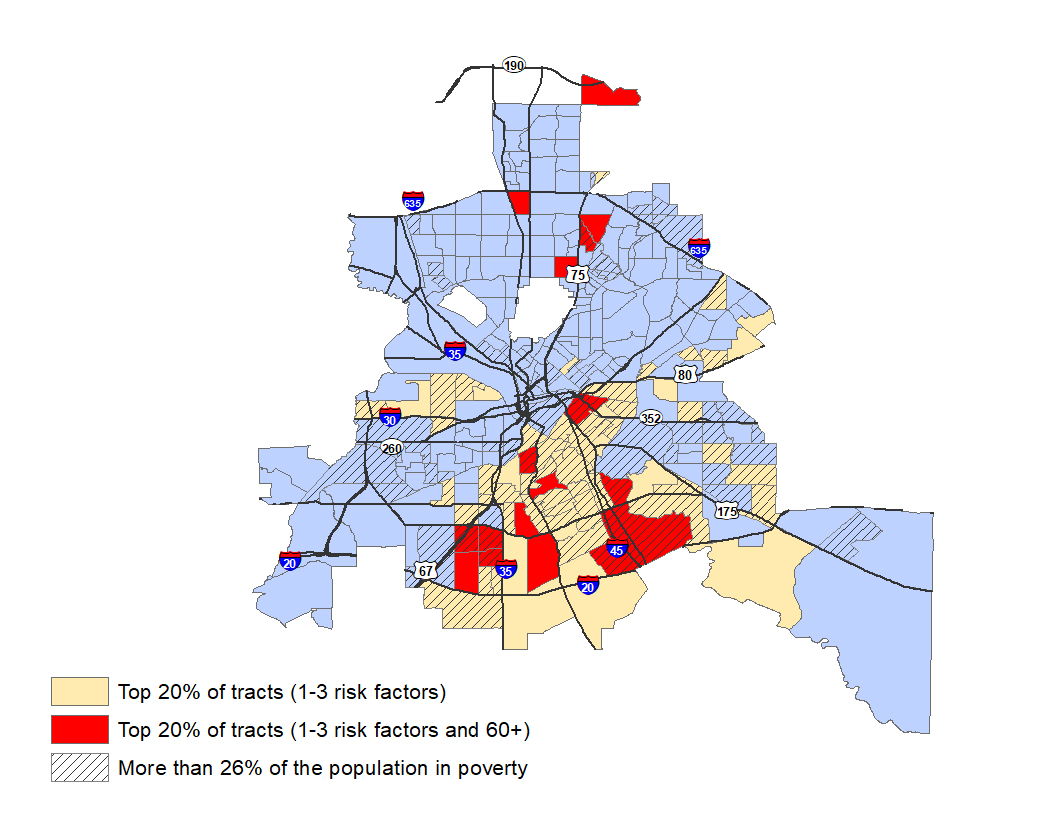
STATUS?
Since 2017 Downwinders has purchased five portable Aeroqual PM 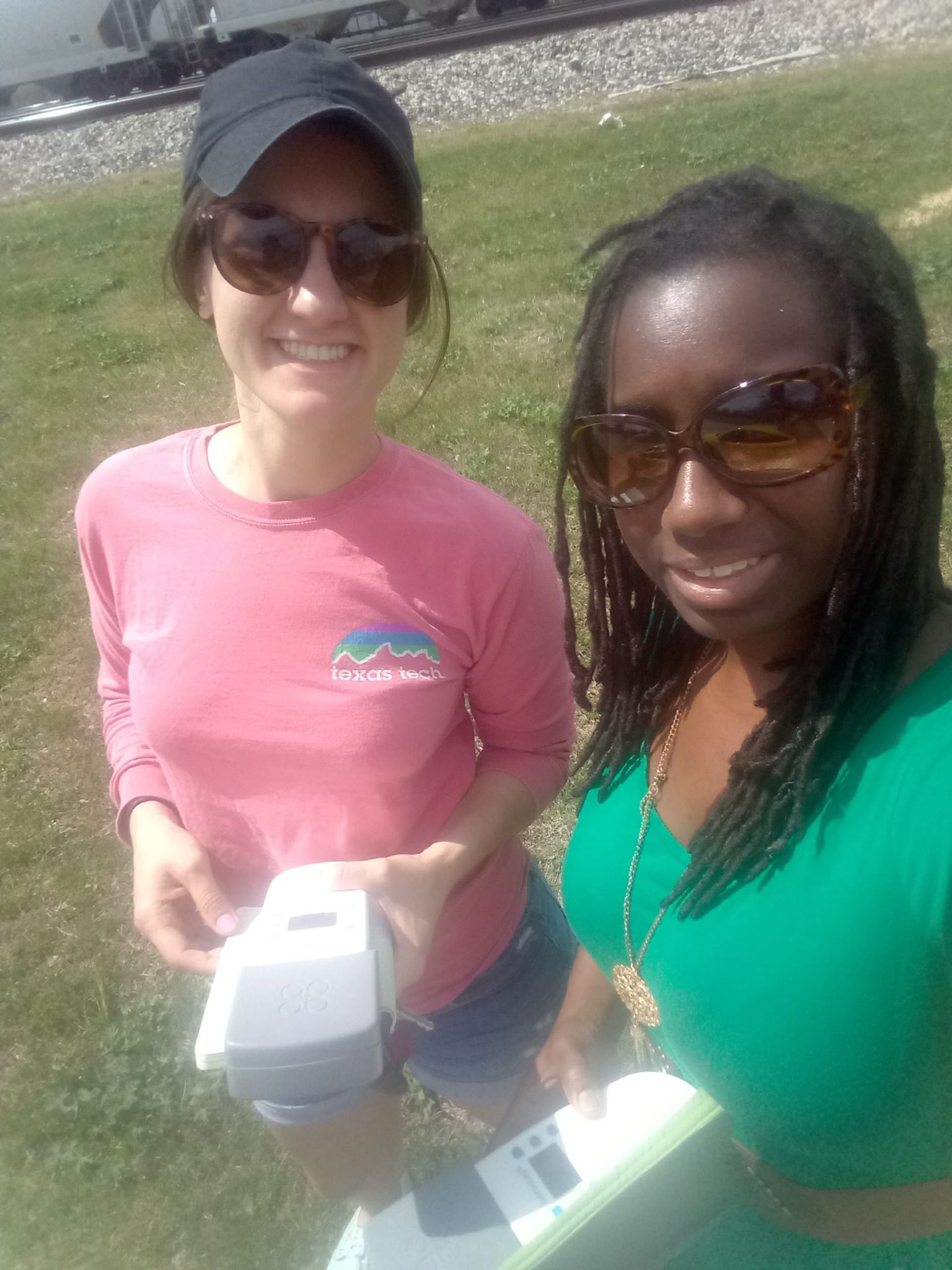 monitors that have been used to track PM Air pollution in DFW and identify hot spots. These portable monitors were the first to record PM levels in the Joppa community in Dallas and the Shingle Mountain illegal dump. We also offer free training in how to use these monitors.With UTD and others, Downwinders is building a 100 + PM monitor network for DFW to track the pollutant in real time across the region.
monitors that have been used to track PM Air pollution in DFW and identify hot spots. These portable monitors were the first to record PM levels in the Joppa community in Dallas and the Shingle Mountain illegal dump. We also offer free training in how to use these monitors.With UTD and others, Downwinders is building a 100 + PM monitor network for DFW to track the pollutant in real time across the region.
Dallas’ climate plan sets goals for electrification of the DART bus fleet by 2040 but other cities are moving faster.
For the last three years debate over the siting of proposed new batch plants has raised the profile of Particulate Matter at Dallas City Hall and around North Texas.

